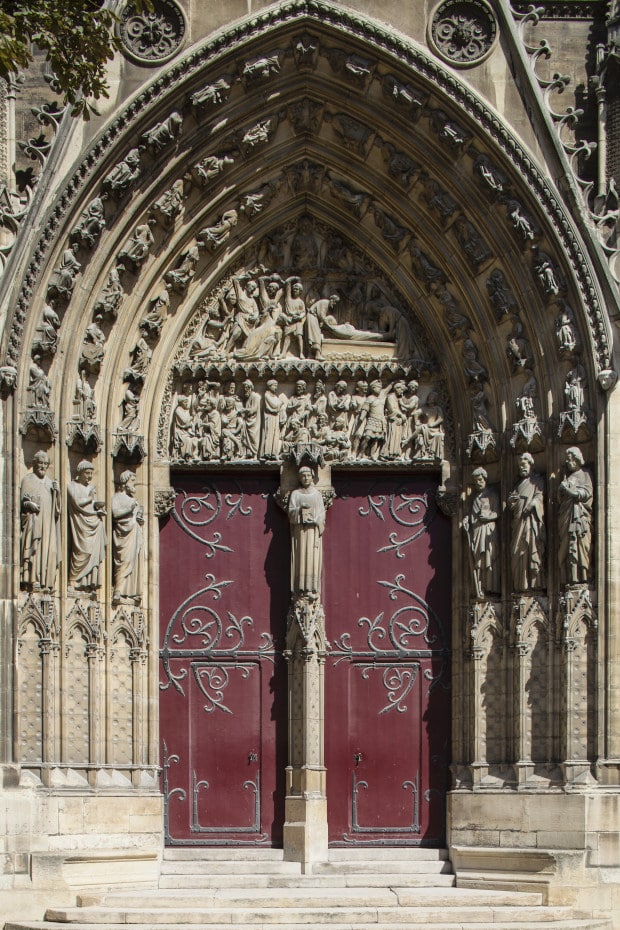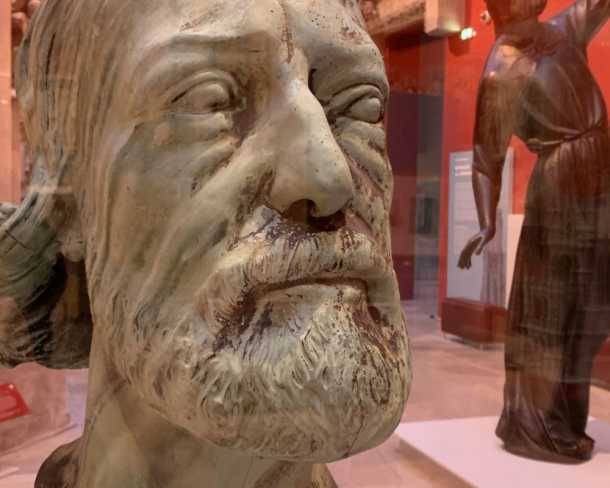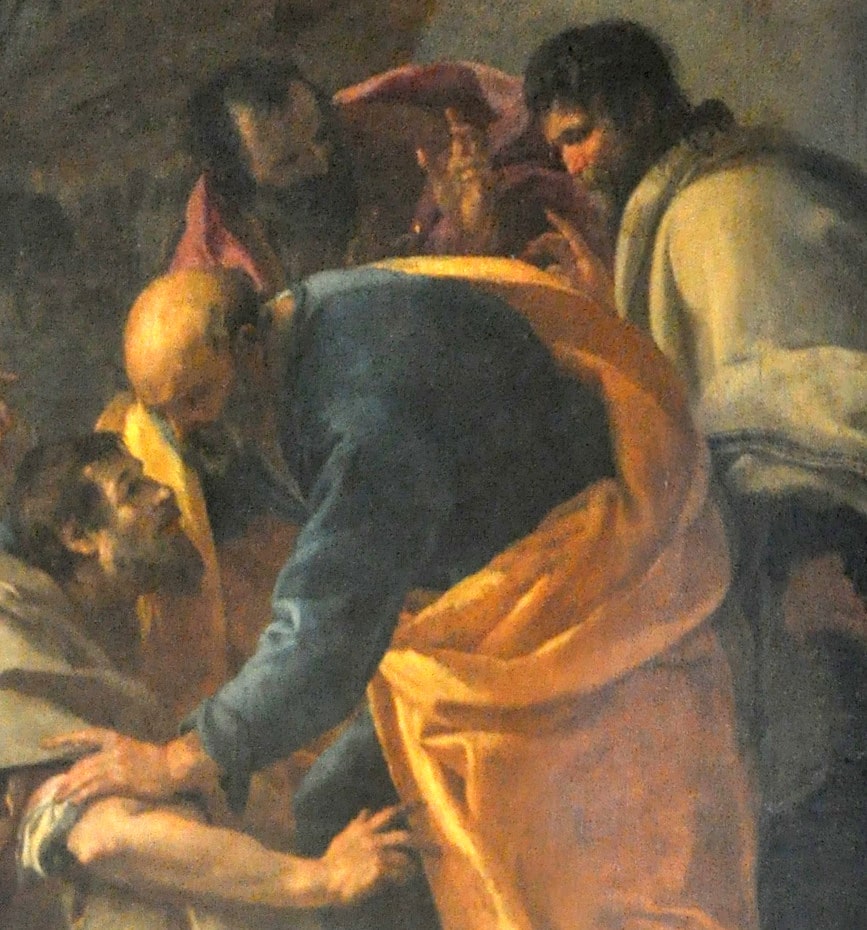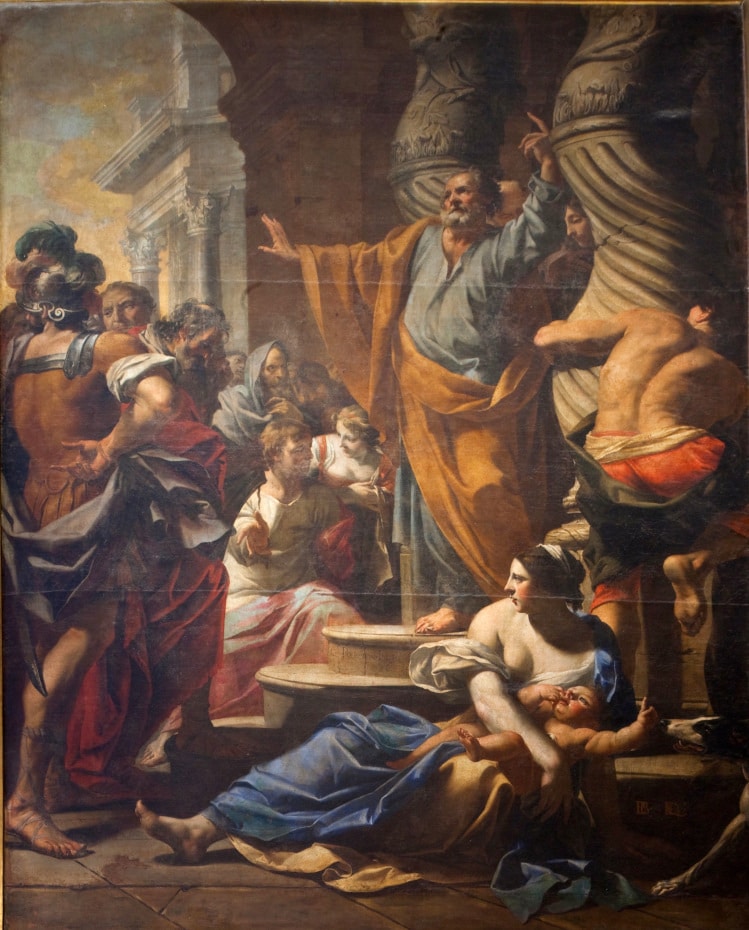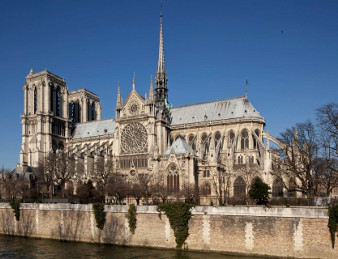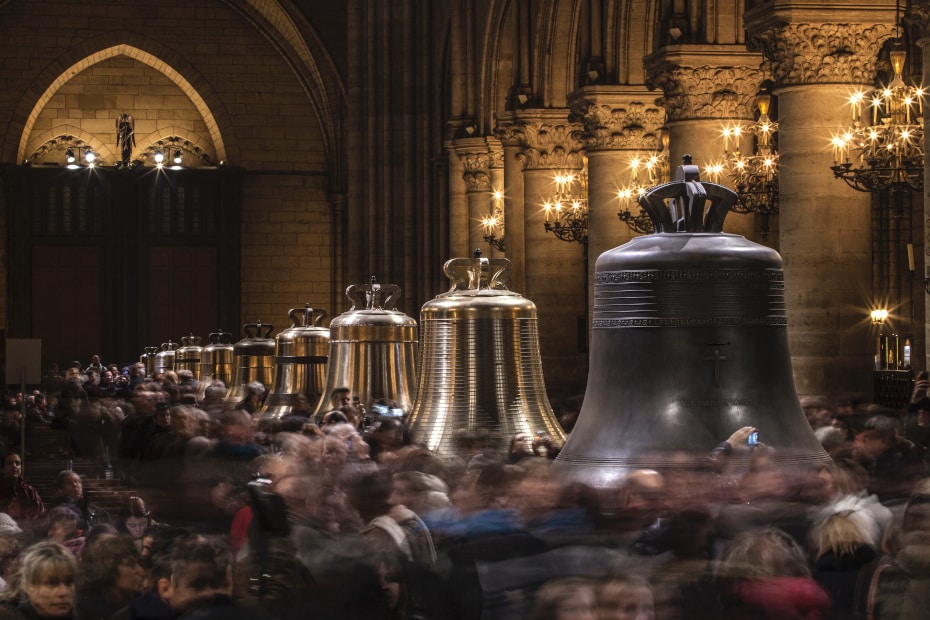Saint-Etienne Portal
The portal of the south transept pays homage to Stephen (Etienne in French), the first Christian martyr. It evokes the name of the first cathedral church in Paris. Built in the 13th century, it was extensively restored in the 19th century.
The Saint-Étienne portal closes the south arm of the transept. Begun by Jean de Chelles, it was finished by Pierre de Montreuil following de Chelles’ death in 1258. The tympanum of the portal tells in bas-reliefs the life of Saint Stephen. Divided into three superimposed horizontal registers, the decoration of the tympanum can be read from bottom to top and from left to right. In the lower register, Saint Stephen preaches Christianity and then he is brought before the judge. The stoning of Saint Stephen and his entombment take place in the middle register. The top register depicts Christ blessing him, surrounded by angels. On the trumeau, the central pillar between the two doors, is the statue of Saint Stephen, a work by Geoffroi-Dechaume reconstructed in the 19th century.
The triple arch of the door is sculpted with twenty-one martyrs crowned by angels, among whom are Saint Denis, Saint Vincent, Saint Eustache, Saint Maurice, Saint Laurent, Saint Clement, Saint George and others whose identity is not determined. On each side of the portal, the three statues of apostles date from the 19th century restorations. They replace the original versions that disappeared during the French Revolution. The high niches above the openwork gallery house the statues of Moses and Aaron.
Above the Saint-Étienne portal, stained glass windows offered by Saint Louis adorn the rose window, 13 meters in diameter. During restoration work in the 19th century, the architect Viollet-le-Duc noticed a drooping of the masonry. In addition, the rose window has suffered over the centuries and during the fire started by insurgents in 1830. To consolidate everything, Viollet-le-Duc picked up the facade and rotated the rose window by 15 degrees on its vertical axis. The master glassmaker Alfred Gérente restored the 13th century stained glass windows and recreated the missing medallions in the spirit of the Middle Ages.
Pierced with an openwork rose in proportion to the large rose window, the gable is located on the top floor of the façade, above the rose window. It illuminates the roof of the transept. A gallery runs behind the balustrade that runs along the roofs of the cathedral from east to west. Two large pyramidions flanked on the gable form the upper parts of the buttresses. Three statues decorate the top, representing Saint Martin and Saint Stephen, and Christ appearing in a dream to Saint Martin who, according to legend, gives his mantle to the poor.
Portal of the Virgin
Located on the left side of the west façade, the portal of the Virgin evokes, according to the tradition of the Church, the death of Mary, her assumption to paradise and her coronation as queen of heaven. It was put into place around 1210-1220.
Notre-Dame Cathedral is dedicated to Mary, and this portal is particularly dedicated to her. The Virgin and Child, placed in the center on the pillar between the two doors, tramples on the serpent, the symbol of Satan. The four seasons are represented on the left and the four ages of life on the right. They remind the faithful of the rhythm of life from the moment they enter the cathedral. Under the pillar, a bas-relief represents the story of Adam and Eve in three sequences: Adam and Eve in the Garden of Eden (or earthly paradise), the temptation of Adam and original sin (the devil is represented under the form of Lilith, an alluring woman with a long serpent's tail) and the expulsion of the first men from the Garden of Eden.
The tympanum is located above the two doors. On the lower lintel, three prophets appear on the left and three Kings of Israel on the right, holding small leather boxes inscribed with biblical texts. The heavenly Jerusalem is placed under a canopy. A chest symbolizes the Ark of the Covenant materializing God's promise to his people. Mary is considered the new Ark of the Covenant. The upper lintel represents the death of Mary surrounded by Jesus and the twelve apostles, Paul under a fig tree and John under an olive tree. Two angels lift her shroud to carry her to heaven. At the top of the tympanum of the portal of the Virgin, Mary is in paradise, seated and crowned by an angel. Jesus blesses her and gives her the scepter. Sacred Queen of Heaven, she sits beside her son. Around them, in the four arches of the portal, angels, patriarchs, kings and prophets make up a heavenly court.
Nine standing statues are placed on each side of the two doors. On the left, the statues represent the Emperor Constantine, an angel, Saint Denis and another an angel. On the right, they represent Saint John the Baptist, Saint Stephen, Saint Geneviève and Pope Saint Sylvester. Saint Denis, Saint Geneviève and Saint Marcel are the patron saints of Paris. Their presence at the entrance to the cathedral is a reminder of their benevolent protections over the faithful who enter Notre-Dame Cathedral. These statues, destroyed in 1793 following the French Revolution, were rebuilt in the 19th century under the direction of Viollet-le-Duc. The pillars of the two doors evoke the twelve months of the year. On the left, the signs of the zodiac symbolize the cycle. On the right, works of the months represent the terrestrial cycle. The stained glass windows of the western rose echo these themes.
Saint Anne Portal
Located on the right side of the west façade, the Saint Anne portal is the oldest of the three portals, installed around 1200. It depicts episodes from the childhood of Christ. In the center, the Virgin and Child are flanked by the King of France and the Bishop of Paris, a testament to the close ties between royalty and Christendom.
The Saint Anne portal is in the Romanesque style, and in fact some carved pieces in the portal were recovered from a from a tympanum made fifty years earlier for the old Saint Stephen's Cathedral. This is why its Romanesque style seems more archaic compared to the other two portals on the west façade.
The central pillar, between the two doors, represents Saint Marcel, the bishop of Paris in the 4th century. He crushes a dragon, symbol of the plagues afflicting his diocese. The original statue was damaged during the French Revolution and replaced in the 19th century. Nine full-length statues arranged on each side of the two doors were also rebuilt in the 19th century under the direction of Viollet-le-Duc. They represent on the left a king, the Queen of Sheba, King Solomon and Saint Peter; on the right Saint Paul, King David, Bathsheba and another king. The hinges, forged fittings, are an exceptional example of ironwork in the Middle Ages.
This portal is dedicated to Saint Anne, the mother of Mary. Below the tympanum, the two lintels in the lower part represent the marriage of Joachim and Anne (Mary’s parents) and that of Mary and Joseph (the parents of Jesus). The upper part tells of scenes from the life of Christ: The Annunciation (announcement of the angel Gabriel to Mary), the Visitation to Mary (visit of Elizabeth, mother of John the Baptist, to Mary), the Nativity (birth of the Christ in Bethlehem), and Epiphany (adoration of the Three Kings).
Like queens in the Middle Ages, the Virgin and Child stand on a throne, under a canopy, and wear royal attributes: the crown and the scepter. She holds on her knees her son Jesus who blesses the faithful and presents the Book of the Law. This representation of the Virgin and Child is characteristic of the Romanesque style by a frontal, hieratic attitude. This style draws its inspiration from the Greco Byzantine style by the succession of small pleats on the clothing.
The identities of the characters representing the bishop of Paris (on the left) and a king of France (on the right) remain unknown. They could be the bishop Saint Germain and the king Childebert, founder of the abbey of Saint-Germain-des-Prés, who died in Paris in 558. Or they could represent the bishop Maurice de Sully and King Louis VII, the first sponsors of the cathedral. In the concentric arches above the tympanum, the heavenly court (angels, kings, prophets and elders of the Apocalypse) sing the glory of God.
Portal of the Last Judgement
The portal of the Last Judgment was installed on the west façade between 1220 and 1230. It represents the judgment of God, according to Saint Matthew, where the accursed are chastised and the blessed are welcomed into eternal life.
The portal of the Last Judgment was installed after the other two portals on the facade. It represents, in Christian iconography of the Middle Ages, the judgment of God when the soul of the deceased is resurrected. According to Christian tradition, God "will judge the living and the dead". The Gospel of Saint Matthew records the words of Jesus: "what you did to the least of one of my brothers, you did it to me".
On the lower lintel, the dead rise and leave their graves. The angels sound the trumpet. These figures include a pope, a king, women, warriors, and an African man. At the top lintel, Archangel Michael weighs souls and two demons try to tip the scales. The chosen are led to paradise (at the right hand of Christ) while the damned, chained and terrified, are led by other demons to hell.
On the tympanum, Christ is seated in glory. He shows the wounds on his hands and his side. Two angels carry the instruments of the crucifixion: the spear and nails for one, the cross for the other. Mary and Saint John kneel on either side. As in the other portals, the celestial court occupies the arches: angels, patriarchs, prophets, theologians, martyrs and virgins. Hell occupies the right of the arches. The "wise virgins" (to the right of God) symbolize the hope of reaching paradise, carrying lighted lamps, while the "foolish virgins" carry extinguished lamps. In the center of the portal, on the pillar between the two doors, the teaching Christ stands on a plinth.
On either side of the doors, the sculptures represent the twelve apostles. On the left are Bartholomew, Simon, James the Younger, Andrew, John and Peter, and on the right are Paul, James the Elder, Thomas, Philip, Jude and Matthew. In 1792, the revolutionaries destroyed these statues, so the statues we see today are replacements. At the foot of the Twelve Apostles, medallions represent virtues and vices, a theme repeated on the stained glass windows of the western rose window.
The portal of the Last Judgment underwent two important modifications in the 18th century. The first, in 1771, occurred when the architect Germain Soufflot removed the pillar and the central part of the two lintels because the Archbishop wanted to facilitate the passage of the canopy during processions. A wooden arch evoking Mary enhanced with a crown worn by two angels replaced the gap. Two doors replace the heavy door panels, one carved with Christ carrying his cross; the other of Maria Dolorosa, Mary weeping in pain over the death of her son. The second modification dates from the cathedral’s major restoration in the 19th century. During this campaign, the architect Viollet-le-Duc reverted the portal to its original state. He restored and replaced the overmantel, the statues of the wise virgins and the foolish virgins, and the statues of the twelve apostles.
